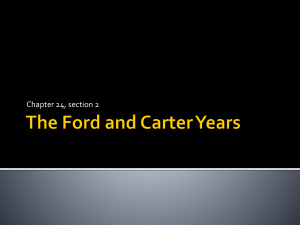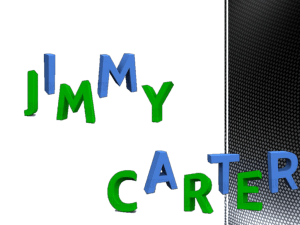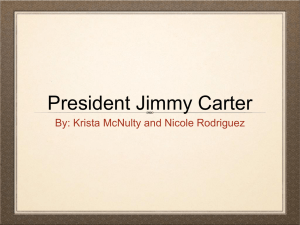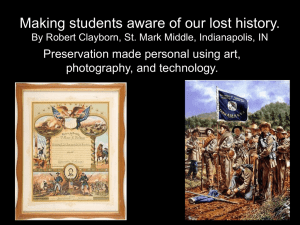Lec 18. - Biophysical Society
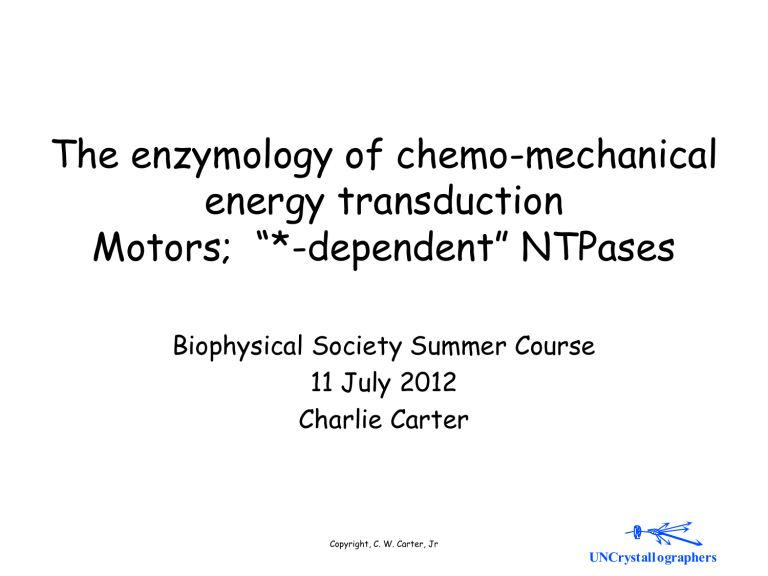
The enzymology of chemo-mechanical energy transduction
Motors; “*-dependent” NTPases
Biophysical Society Summer Course
11 July 2012
Charlie Carter
Copyright, C. W. Carter, Jr
UNCrystall ographers
Readings
• Nelson, P., Biological Physics, Chapter 10
• Howard, Jonathan, Mechanics of Motor Proteins and the
Cytoskeleton, Sinauer Associates, Sunderland, MA
– Chapter 12 Structures of Motor Proteins
– Chapter 14 ATP Hydrolysis
– Chapter 16 Motility Models
Copyright, C. W. Carter, Jr
UNCrystall ographers
Copyright, C. W. Carter, Jr
UNCrystall ographers
Questions
• What does “Transduce” mean?
• Why is NTP hydrolysis so special?
– It is quite slow in water; needs a catalyst!
– It explosively exergonic (ie., favorable) in water!
• How does water change the equilibrium constant for NTP hydrolysis?
• Why are pre-steady state and steady state rates different?
• What does “energy storage” mean?
• What does it mean when product release is rate limiting?
• Examples of coupling:
– Myosin cross-bridge cycle: an actin-dependent ATPase
– F1 ATPase cycle: a work-dependent ATP synthase.
– Kinesin cycle: a tubulin-dependent ATPase
– GroElEs cycle: an improperly folded protein-dependent ATPase
– RAS cycle: a signaling GTPase with two dependencies
Copyright, C. W. Carter, Jr
UNCrystall ographers
Transduction (from the OED)
transduce (tr":n s£dju:s, trÊns-, -nz-), v.
1. trans.
To alter the physical nature or medium of (a signal); to convert variations in (a medium) into
corresponding variations in another medium.
Copyright, C. W. Carter, Jr
UNCrystall ographers
NTP hydrolysis fuels everything in the cell!
A reaction that is explosively irreversible in water …
Keq >> 1.0
ATP + H
2
O ADP + P i
…
Becomes reversible inside a protein that can absorb the explosion..
.
Keq ~ 1.0
ATP + H
2
O ADP + P i
…by changing shape, which stores free energy.
These shape-changes drive all cellular processes!
Copyright, C. W. Carter, Jr
UNCrystall ographers
A thermodynamic cycle with an labile substrate => 3 states!
Conformational
Equilibria
Binding
Equilibria
Copyright, C. W. Carter, Jr
+
D G = 0
For a complete cycle
UNCrystall ographers
3-State behavior and free energy transduction
Motors F1 ATPase
Closed,
Triphosphate Keq ~ 1 !!!
Open,
Ligand-free
Copyright, C. W. Carter, Jr
Closed, diphosphate
UNCrystall ographers
Tubulin thermodynamic cycles show Keq ~0
NTP
NDP + Pi
Free solution Tubulin subunit Microtubule
Caplow, Ruhlen, & Shanks (1995) J. Cell Biol., 127:779-788
Copyright, C. W. Carter, Jr
UNCrystall ographers
The quench-flow technique: perchloric acid
S
Perchloric acid quench
Copyright, C. W. Carter, Jr
UNCrystall ographers
Ed Taylor: energy transduction revealed
Myosin vs Actomyosin
20/s
0.1/s
Steady-state
~100/s
Transient phase
Copyright, C. W. Carter, Jr
UNCrystall ographers
Howard, J. (2001) Mechanics of Motor Proteins and the Cytoskeleton, Ch. 14
Copyright, C. W. Carter, Jr
UNCrystall ographers
Copyright, C. W. Carter, Jr
UNCrystall ographers
Copyright, C. W. Carter, Jr
UNCrystall ographers
X-ray kinetics correlates cross-bridge activity , tension
Copyright, C. W. Carter, Jr
UNCrystall ographers
Copyright, C. W. Carter, Jr
UNCrystall ographers
Copyright, C. W. Carter, Jr
UNCrystall ographers
Copyright, C. W. Carter, Jr
UNCrystall ographers
Copyright, C. W. Carter, Jr
UNCrystall ographers
Work is done only when cross-bridges are attached
Length of power stroke
Copyright, C. W. Carter, Jr
UNCrystall ographers
T. Hill’s account of the actomyosin free energy cycle
The amount of work done each cycle depends on how much is lost in vertical drops!
Copyright, C. W. Carter, Jr
UNCrystall ographers
Ron Milligan’s myosin movie
Copyright, C. W. Carter, Jr
UNCrystall ographers
Ron Milligan’s kinesin movie
Copyright, C. W. Carter, Jr
UNCrystall ographers
Differences between myosin, kinesin ATPases
Product (ADP) Release
Release from track
ATP hydrolysis
Rate limiting step
Duty Ratio (%time attached)
Cross-bridge stiffness
Speed
Myosin
Strengthens actin binding
Promoted by ATP binding
While Detached from actin
Occurs while detached
0.035 - 0.14
5pN/nm
6000 nm/s
Kinesin
Exhange Promotes power stroke
Promoted by ATP hydrolysis
While Bound to m T
Occurs while attached
0.5 - 1.0
~0.5pN/nm
800 nm/s
UNCrystall ographers
ATP Synthase
• CS3 and CS38
• Solved in pieces: F1,F0
• Nobel Prize (Chemistry)
1997
Stator
(unknown)
Rotor (F
0
)
Copyright, C. W. Carter, Jr
UNCrystall ographers
Translocating protons down a gradient can drive rotaty motion: molecular motors
Copyright, C. W. Carter, Jr
UNCrystall ographers
Copyright, C. W. Carter, Jr
UNCrystall ographers
b
E
-subunit a
TP
-subunit
Non-exchangeable ATP g -subunit,
N-terminal helix
Copyright, C. W. Carter, Jr
UNCrystall ographers
Strand 3
B-helix
Copyright, C. W. Carter, Jr
UNCrystall ographers
Copyright, C. W. Carter, Jr
UNCrystall ographers
Why don’t the examiners pose questions to candidates other than in a twisted manner? It seems that they fear being understood by those they are interrogating; what is the origin of this deplorable habit of complicating the questions with artifical difficulties?
-
Evariste Galois, French Mathematician, inventor of Group Theory
Copyright, C. W. Carter, Jr
UNCrystall ographers
Study Questions
Use the data on slide #12 to calculate the Keq for ATP hydrolysis within the
Myosin Active site.
Use slide #21 to discuss why there has to be an elastic component for any working motor to be at all efficient.
AMPPNP is often thought to be a “non-hydrolyzable” ATP analog. Yet, it drives the accumulation of Ca 2+ by the sarcoplasmic reticulum pump. Use these ideas to deconstruct the next sentence. In skeletal muscle fibers depleted of ATP (Rigor), AMPPNP causes a:
– Rapid, fully reversible, stress-independent increase in the rest length
– Whilst the Isotonic stiffness remains within 2% of the Rigor value.
Use your answer to the previous question to discuss how, if primates had prehensile tails consisting largely of thin and thick filaments might be able to synthesize ATP by bungi jumping.
Copyright, C. W. Carter, Jr
UNCrystall ographers

